Brochure of Seismic Isolation Systems in Japan
What a seismically isolated building is, how a seismically isolated building moves during an earthquake, and the design advantages of a seismically isolated building are explained in the introduction.
Next, regarding the seismic isolation device, what a seismic isolation device is and how to combine and arrange them are shown. It also mentions evaluating the performance of seismic isolation devices.
More about construction work, it details the construction process and concludes with an explanation of building maintenance and management.
This brochure provides an easy-to-understand explanation of seismic isolation systems.
Design approach
Differences in design approach (including seismic motion) between Japan and overseas countries
Even if we share design information on seismic isolation structures in Japan, if the design philosophies or paradigms of overseas engineers is different, they will not understand it.
No matter how good the information is, it will not be used.
In the same way that a common language is necessary, there is a need for dictionary-like document that shows the differences in design approach between Japan and overseas countries.
▶Design Method
Japan:Two-stage design: allowable stress design using the factor of safety of members considering the criteria for elastic stress; and, ultimate strength design using the structural ductility factor (Ds value) considering the plasticization of members based on elasto-plastic analysis.
The final design must satisfy the design criteria for all response values (e.g. inter-storey drift) of multiple seismic ground motions.
The designer has the concept of "elastic state" and "elasto-plastic state.
Overseas (Europe and American type):
The q factor and R factor take into account the plasticity of the structure and the stress reduction due to the difference between elastic and elasto-plastic analysis i.e. ductility.
(For each criterion, the factor of safety is also considered in the load combinations.)
The design is evaluated, but engineers tend to exclude the maximum and minimum response values for multiple earthquake ground motion response values (in some cases, the average of these values is used).
The concepts of "elastic state" and "elasto-plastic state" are well-known to academics and researchers, but are rarely used by structural designers in practice.
In the case of seismic response analysis, all of the response values are used in the design for Japan, while the average of the response values is used in the design for overseas countries.
▶Seismic motion
Seismic motion for building design in Japan :Two levels of design seismic input with 50-year return period motions which represents " rarely occurring ground motion " and 500-year return period motions which represents " extremely rarely occurring ground motion" are considered.
(The variation of the regional coefficient factor is quite small for locations within Japan. The amplification factor of the surface ground below proposed buildings is evaluated separately. Legally, the importance factor is not included in the Japanese standard, but may be considered on a project-by-project basis.)
Earthquake motion used for design in overseas countries.:Many countries specify the return period against the design criteria (service limit and safety limit).
The return period is assumed to be 475 years in EU (Eurocode) and 2500 years in US (IBC) (in the US, the design base shear is 2/3 of the 2500-year MCE ground accelerations, about 500 years in practice).
(The variation in regional factor is significant. Amplification factors for surface soils are evaluated separately. There are various importance factors defined in each code.)
ISO 23618:2022
Bases for design of structures – General principles on seismically isolated structures
1. Introduction
In order to spread the seismic isolation technology more widely and internationally, it is necessary to develop internationally harmonized standards for ensuring the performance of the seismically isolated structure.
As an earthquake-prone country, Japan has been actively involved in the establishment of ISO standards related to seismic design and loading. The ISO standard on seismic action, ISO 3010, "Bases for the design of structures - seismic action on structures", was published in 1988 by a WG (Working Group) with Japan as a convener. This ISO standard has been reviewed since its establishment, and the third edition was completed in 2017. In 2020, the Japanese domestic standard JIS A 3306 based on the ISO 3010 was published.
In 2005, ISO 22762, “Elastomeric seismic-protection isolators” was published based on the proposal from Japan. Subsequently, in 2011, the Japanese domestic standard JISK 6410 was established in accordance with the ISO 22762.
In order to establish an ISO standard for design methods for seismically isolated structures, a WG with Japan as a convener was established at the ISO/TC98 meeting in Prague in 2018. The members of the WG were nominated from member countries of ISO/TC98/SC2. Although activities of the WG were stalled for a time due to the COVID19, ISO 23618, “Bases for design of structures – general principles on seismically isolated structures” was successfully published in October 20225).
2. Outlines of ISO 23618
The standard contains basic requirements for the design of seismically isolated structures. Only the main points are listed below.
(1)Target performance of seismically isolated structures
The target performance of the seismically isolated structure is described as follows:
a. The structure should be able to maintain its function with no damage against earth-quakes that may occur during its service life (serviceability limit state).
b. The structure should have limited damage and be repairable, and be able to maintain its function even immediately after the earthquake against the maximum earthquake that may occur at the site (ultimate limit state).
c. The description also states that the structure has sufficient redundancy to protect the occupants against unpredictable natural occurrences and accidents.
It also states the target performance of the superstructure, sub-structure, and the seismic isolation system.
(2) Design seismic force
It describes that the seismic motion and design response spectrum shall conform to the ISO 3010 "Bases for the design of structures - seismic action on structures". The design response spectrum shall be used for the response spectrum analysis using an equivalent linear system, and that the design seismic motion shall be used for the time history response analysis.
(3) Structural analysis method
A. Response spectrum analysis
For the response spectrum analysis using an equivalent linear system, the requirements are as follows:
a. The building must be base-isolated, the superstructure must be sufficiently stiff compared to the seismic isolation layer;
b. Higher-order vibration modes must be negligible;
c. Torsional behavior must be unlikely to occur;
d. The nonlinear restoring force of the seismic isolation system must be expressed by the equivalent restoring force using the equivalent stiffness and the equivalent damping;
e. The upper and lower limits of the restoring force characteristics should be considered in the analysis;
f. The superstructure is designed using the maximum shear force of the isolation system, and no tensile force acts on the isolators.
It also describes the design equations for obtaining the equivalent period, equivalent damping factor, maximum response value, and shear force of the superstructure.
B. Time history response analysis
In the time history response analysis, the requirements include:
a. The nonlinear restoring force characteristics of the seismic isolation layer shall be explicitly modeled based on the constitutive law of the isolation system;
b. The tensile force acting on the isolation system shall be limited;
c. The fatigue characteristics of the isolation system against earthquake and wind shall be appropriately considered.
It also describes that a sufficient number of earthquake motions should be used in accordance with the ISO 3010, and that the upper and lower limits of the variation of the stiffness and bearing capacity of the seismic isolation system should be considered in the analysis.
(4) Construction management and maintenance
The standard describes the basic items for construction management to be checked by the designer for each of the following: construction plan, quality control of the seismic isolation system, temporally construction plan, and construction procedure of the seismic isolation layer.
It also describes the maintenance of the seismic isolation system, performance monitoring, and warning signs for occupants. Furthermore, it requires the designer to confirm the performance information of seismic isolation devices, testing of the seismic isolation devices in accordance with ISO 22762.
(5) Appendices
In addition to the main text of the standard, the following Appendices are pre-pared:
A. Classification and performance characteristics of isolation devices,
B. Construction management of seismically isolated structures,
C. Maintenance of seismically isolated structures,
D. Wind-resistant design of seismically base isolated buildings, and
E. Mid-story seismically isolated buildings.
Articles about Seismic Isolation
The 2016 Kumamoto Earthquake
▶Effect of seismic isolation structure during the Kumamoto earthquake, Recommendation of seismic isolation Part 5:
Seventeen buildings with seismic isolation were surveyed after the 2016 Kumamoto earthquake, most of which were apartment houses and hospital buildings. These buildings did not suffer any structural or non-structural damage and maintained their functionality even after the earthquake shaking of Seismic Intensity (JMA) 5 to 6. The seismically isolated medical facilities continued to operate without any problems and were able to accept patients from the nearby non-seismically isolated medical facilities that were severely damaged. The residents of the seismically isolated apartment buildings were satisfied with the performance of the building—being able to continue their daily lives, without any furniture falling over. The survey verified that the seismic isolation components such as the rubber bearings and the steel dampers performed as expected. In a few buildings, minor damage was observed in the expansion joints, external evacuation stairs, and ceilings around the perimeter of the seismically isolated buildings. These observations highlight the need to properly design these buildings with a thorough understanding of the characteristics of the seismic isolation systems.
▶Seismic Isolation Report "2016 Kumamoto Earthquake"
The report summarizes the performance of the seismically isolated apartment buildings in the Kumamoto Earthquake based on interviews with the apartment owners, facility managers, and structural designers. Although the nearby non-seismically isolated building suffered considerable damage such as stoppage of the elevators, damage to the façade and furniture, the seismically isolated apartments did not suffer any damage, not even toppling of furniture. This earthquake also demonstrated the benefits of using seismic isolation in buildings, even if the initial cost is comparatively higher. The residents of the apartments said that they felt safe and were satisfied with the performance of the isolated building in the Kumamoto Earthquake. In addition, the residents of the nearby non-seismically isolated buildings came to take shelter in the seismically isolated apartments. After the earthquake, there is increased interest in the seismically isolated buildings due to the safety and peace of mind of occupants.
The 2011 off the Pacific coast of Tohoku Earthquake
▶Seismic isolated buildings reduce earthquake shaking by half and are effective for a long period of time
The analysis of acceleration and displacement measurements obtained from multiple seismically isolated buildings in the 2011 Great East Japan (Tohoku) Earthquake confirms that seismic isolation is effective in controlling the seismic response under long duration earthquakes. The observation data showed that the seismic isolation reduced the shaking by up to one-third of the ground shaking. The reduction in maximum acceleration and magnitude of sway of the building elucidate the advantage of the seismic isolation system in terms of continuous use and reducing the psychological anxiety of the occupants. The effectiveness of seismic isolation for short period earthquakes (seismic source in close vicinity of the building) has been well documented.
Article publication date: 16:01, July 4th, 2011
The content of Asahi Shimbun Digital articles may change without notice.
▶Visiting Report, Japanese Red Cross Ishinomaki Hospital
The Japanese Red Cross Ishinomaki Hospital saved many lives during the 2011 Great East Japan (Tohoku) Earthquake. This hospital was designed as a seismically isolated structure with the objective of maintaining the continuous use of the hospital in the event of strong earthquakes. This report summarizes the contents of the visit to the hospital after the Tohoku Earthquake and discussion with the designers and stakeholders. This building did not suffer any structural damage in the Tohoku Earthquake and there was no problem with the high-performance medical equipment such as MRI and CT. This hospital was able to function effectively as a disaster base during the Tohoku Earthquake, ensuring continued functionality and saving lives of many disaster victims, as aimed in the structural design.
▶The hospital that sparked the spread of seismic isolation structures, the Japanese Red Cross Ishinomaki Hospital
The Japanese Red Cross Ishinomaki Hospital located in the Ishinomaki city, one of most heavily affected cities by the 2011 Great East Japan (Tohoku) Earthquake, was the only hospital in that area to be able to maintain its function immediately after the earthquake. This seismically isolated hospital was used as a disaster base after the earthquake and was able to save many lives as a result of its excellent seismic performance. In addition, this hospital helped to demonstrate the effectiveness of using seismic isolation and provided significant momentum for the adoption of seismic isolation structures.
In the 2011 Tohoku Earthquake, seismic isolation installed near the base of the hospital building reduced the floor acceleration response, preventing important medical equipment from falling and getting damaged. This reduction contributed greatly to ensure the functionality of the hospital after the earthquake. The electrical and plumbing facilities were designed with continuous functionality in mind and were able to perform as targeted in the design, without any damage. The steel dampers installed together with the base-isolation were able to dissipate the input seismic energy effectively to achieve the specified performance. These observations highlight that adopting a seismic isolation structure is the most realistic answer when the objective is to ensure functionality after an earthquake.
The West off Fukuoka Prefecture Earthquake in 2005
▶Reconnaissance Report on the Behavior of the Isolated Buildings during the earthquake of the West off Fukuoka Prefecture in 2005
This article summarizes the observed performance of seismically isolated buildings in the 2005 Fukuoka Earthquake. The surveyed buildings (13 in total) used different combinations of base-isolation and damping systems (high-damping rubber bearing, natural rubber bearing, lead rubber bearing, elastic sliding bearing, steel bar damper, and lead damper), and consisted of office buildings, apartments, hospitals, and hotels.
The survey revealed that the seismically isolation was effective in reducing the floor acceleration of the superstructure (by about one-third to a half) and preventing any damage to the nonstructural components (such as toppling of shelves, furniture, computes, and crockery). The seismic isolation systems were relatively intact without any severe damage. The response exhibited by the seismically isolated buildings was in line with the objectives set during the design (Level-1 or Level-2) of the buildings. The residents/guests of the buildings were satisfied with the performance of the building. Minor damage in the handrails and tiles near the clearance area and expansion joint was observed. This observation highlights the need for carefully considering the movement of the isolation system while designing the facilities around the expansion region.
▶Quick Report on the Behavior of the Ohori Park Building during the Earthquake of the West off Fukuoka Prefecture in 2005
This article summarizes the observed performance of the seismically isolated Ohori Park Building in the 2005 Fukuoka Earthquake. This building (9-story: about 37 meters tall) is an office building with steel-reinforced concrete (SRC) construction and cast-in-place pile foundation. Fifteen natural rubber laminated bearings (diameter, D: 800~900 mm) are installed between the foundation and the first floor, together with eight lead dampers (φ180 mm) and eight steel bar dampers (φ70 mm).
The isolation system was effective in reducing the horizontal acceleration of the building by about one-third to a half of input magnitude (from 110 cm/s2 to 66 cm/s2 in North-South direction; from 146 cm/s2 to 45 cm/s2 in the East-West direction). The maximum displacement of the isolation layer was about 27 cm in the Fukuoka Earthquake. Visual inspection of the bearings and dampers confirmed that there was no damage to the isolation members. A post-earthquake questionnaire survey conducted among the tenants of the building confirmed that the indoor situation after the earthquake was almost the same as before the earthquake, with no lockers or bookshelves falling over. Some cracking of the tiles was observed along the perimeter of the building. However, this minor damage did not hamper the continued use of the building.
The Niigataken Chuetsu-oki Earthquake in 2004
▶The Effect on Seismic Isolation of Information Buildings in Nagaoka City
This is a report on the damage to a four-story seismically isolated RC building in the 2004 Niigata Earthquake. The building is used as an information center. The seismic isolation layer is composed of lead rubber bearings and natural rubber laminated bearings. The structural system and interior fixtures were undamaged in the earthquake. As per the record inscribed in the displacement sheet, the maximum displacement of the isolation layer was about 80 mm. The observed performance of the building and the design calculations were in reasonable agreement. The acceleration response of the building was reduced to 1/3~1/4 of the input ground motion. The residual displacement of the building was 3.5 mm immediately after the earthquake and reduced to 2.6 mm after one month.
▶Earthquake observation records of base-isolated buildings during the Niigataken Chuetsu-oki Earthquake in 2004
This is a report on the damage to a five-story RC medical facility in the 2004 Niigata Earthquake. This building was equipped with a seismic isolation system consisting of natural rubber laminated bearings and elastic sliding bearings. Although the observed seismic intensity in the area was 6-upper (in the JMA scale), the horizontal acceleration of the building was reduced to about 1/4 by the seismic isolation. On the other hand, the vertical shaking had a maximum acceleration of about 750 gal. The maximum deformation of isolation layer is estimated to be around 150 mm. The interior furniture and shelves did not fall or topple over. Only minor damage occurred on the perimeter of the building, which was limited to the extent that it can be easily restored.
The Tokachi−oki Earthquake in 2003
▶Earthqake Observation Result of a Base-lsolated Building in Kushiro City during the Tokachi-oki Earthquake in 2003
This is a report on the damage to a three-story RC office building in the 2003 Tokachi-Oki earthquake. The seismic isolation layer consisted of lead rubber bearings. The observed seismic intensity in the area was 5-upper in the JMA seismic intensity scale. Despite the strong shaking, the seismic isolation system was effective in preventing fall or toppling of nonstructural elements, and there was no damage to the building interior or exterior. Flexible joints around the building did not sustain any damage. The measured seismic response and the numerical results from the seismic response analysis based on the design model agree well with each other.
▶Strong Motion Records Observed at the Kushiro Government Office-Building during the Tokachi-oki Earthquake in 2003
This is a report on the damage to a nine-story government building (SRC construction, one basement floor) in the 2003 Tokachi-Oki earthquake. The seismic isolation layer was placed between the first-floor floor beams and cantilever columns rising from the basement floor. The isolation layer consisted of natural rubber laminated bearings, lead dampers, and steel bar dampers. The maximum horizontal acceleration of the floor above the seismic isolation layer was reduced to about 1/2 of the maximum acceleration at the ground surface. The maximum displacement of the seismic isolation layer was about 120 mm. The observations verified that the seismic isolation system was very effective, as expected in the design, in reducing the shaking intensity and preventing damage to the building.
▶Seismic Behavior of Kushiro-shinyou-kumiai during the Tokachi-oki Earthquake, 2003
This article reports the observed performance of a seven-story seismically isolated office building (RC construction, one basement floor) in the 2003 Tokachi-Oki earthquake. The seismic isolation layer consisted of natural rubber laminated bearings, lead dampers, and steel bar dampers. The maximum deformation of the seismic isolation layer was about 140 mm. It can be inferred from the observed response that the lead dampers and steel bar dampers plasticized in the earthquake and contributed to energy dissipation."
▶Dynamic Behavior of A Base Isolated Hospital Building in Kushiro-City during the Tokachi-oki Earthquake in 2003
This article reports the observed performance of a three-story seismically isolated medical facility (RC construction, one basement floor) in the 2003 Tokachi-Oki earthquake. The seismic isolation layer consists of high-damping laminated rubber bearing. The maximum horizontal acceleration of the building was reduced by a factor of 0.73~0.87 relative to the horizontal acceleration of the foundation. However, the shaking velocity was amplified by a factor of 1.33~1.55. The maximum deformation of the seismic isolation layer was about 150 mm. There was no damage to the building, facilities, or equipment, and medical services were able to continue without any interruption after the earthquake.
The 1995 Southern Hyogo Prefecture Earthquake
▶Matsumuragumi Institute of Technology
This article reports the performance of a three-story seismically isolated RC building in the 1995 Great Hanshin Earthquake. The seismic isolation layer consists of high-damping laminated rubber bearing. The maximum horizontal acceleration of this building was 272 gal at the roof floor, compared to the maximum acceleration of 965 gal in an adjacent building without seismic isolation. This earthquake had a strong shaking, exceeding the Level-1 shaking considered in the design, and included a dominant long-period component around a vibration period of 1.5 seconds. Despite this, the seismic isolation building exhibited excellent performance without any damage.
Seismically isolated structures that functioned well during disasters
▶LATEST TRENDS IN SEISMIC ISOLATION IN TURKIYE(The 2023 Turkey–Syria Earthquakes)
▶Keiju Medical Center "The Miracle of Noto" (The 2024 Noto Peninsula Earthquake)
▶Aso Medical Center (The 2016 Kumamoto Earthquake)
▶Ishinomaki Red Cross Hospital : The hospital that sparked the spread of seismically-isolated structures. (The 2011 off the Pacific coast of Tohoku Earthquake)
▶Earthquake observation records of a seismically isolated hospital in Ojiya City during “The 2007 Niigataken Chuetsu-oki Earthquake”.
▶1994 Northridge Earthquake (M 6.7) The "earthquake-resistant hospital" was the University of Southern California Hospital, which had a seismic isolation system.
Seismic Isolation Buildings in Japan
【Shimizu Corporation New Headquarter】
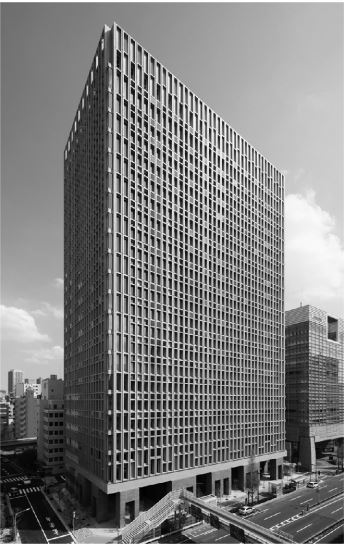
Keywords: Core Wall Structure, Headquarter
This paper introduces the outline of the new headquarters of Shimizu Corporation, which is designed as a reinforced concrete seismic isolated structure, not only to maintain the functions of the headquarters after a major earthquake but also to serve as a disaster prevention base to protect the local community.
The building is a mid-level seismic isolation structure with a seismic isolation layer placed between the first and second basement levels. In addition to the laminated rubber bearings, oil dampers are installed to cope with long-period seismic motion.
While round shape bearings are used in the general sections, square laminated rubber bearings are used in the front of the building for the purpose of space saving. In order to minimize the fluctuation of axial forces acting during earthquakes, the first-floor columns on the outer periphery are placed away from the corners of the building.
【Yozemi Tower Obelisk】
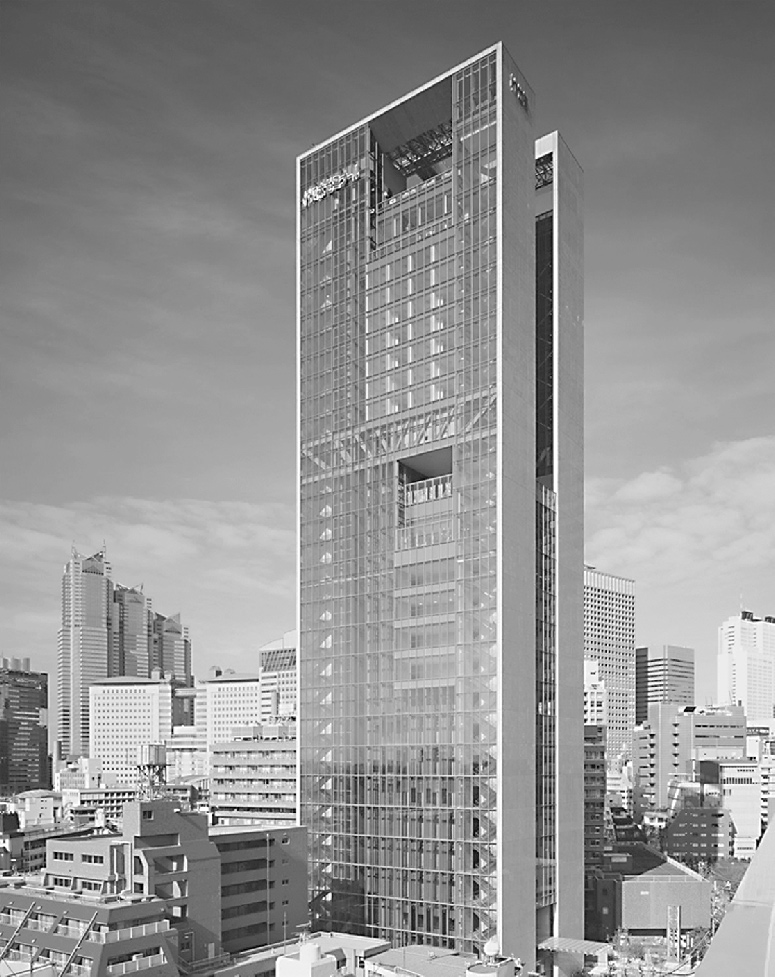
Keywords: High-rise, Semi-active seismic isolation
The building is a 134-meter-high skyscraper consisting of classrooms, offices, and residences. In order to maximize the flexibility of the interior space, multi-layered seismic walls were placed around the perimeter, and in combination with the seismic isolation system, the wall thickness was made as thin as possible to integrate with the architectural design.
By connecting the multi-layered seismic walls on both gable faces with core frames, a large H-shaped structure is formed in plan to increase the building's rigidity and seismic resistance.
The seismic isolation system consists of natural rubber laminated rubber bearings and oil dampers, and a semi-active seismic isolation system was adopted for half of the oil dampers.
【NHK Sapporo, Japan Broadcasting Corporation】
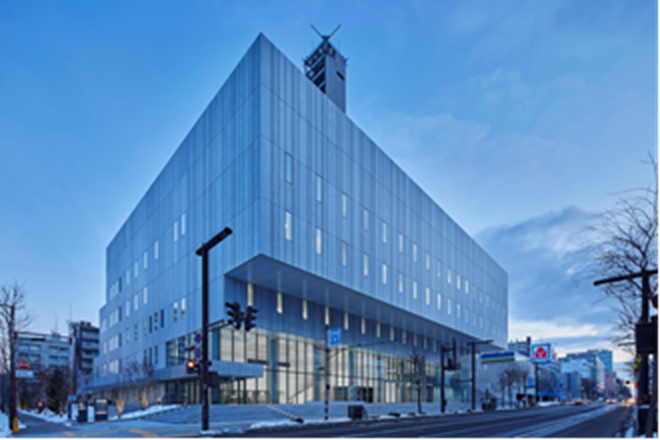
Keywords: Broadcasting base, SRC Seismic Wall
This building is an example of a broadcast hall with high seismic performance that can maintain its broadcasting function even after a major earthquake. For the staircase-shaped cross section and steel tower, a seismic isolation structure was adopted to prevent plasticity of the members and to suppress the twisting of the superstructure and the response of the steel tower.
Due to the difference in mass and stiffness between the approximately 72m steel tower (aspect ratio 1:9) and the main building with SRC earthquake-resistant walls, the plan was to reduce the response of the steel tower by setting the relationship between the natural period TT of the steel tower and the natural period TM of the initial stiffness of the isolation layer to "TM / TT>√2".
【Kansai Gateway】
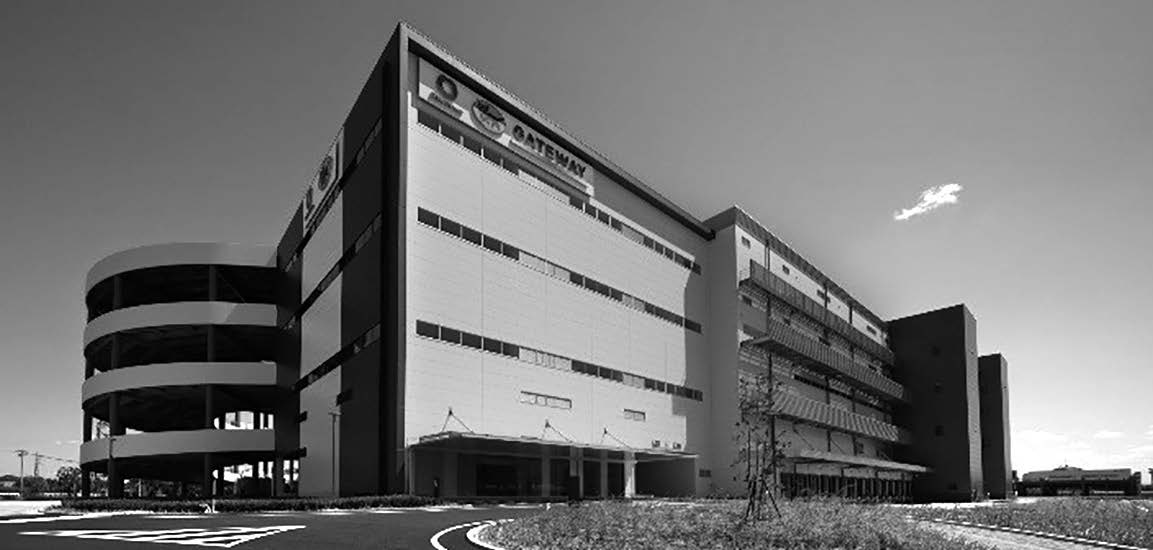
Keywords: Distribution warehouse, Steel Construction
This building is a general logistics terminal that employs a seismic isolation structure to minimize damage in the event of a major earthquake. steel construction instead of RC construction, including the large beams on the first floor, was used to improve workability and shorten the construction period.
Laminated rubber with lead plugs is placed around the perimeter of the warehouse/office area, and natural rubber laminates are placed in the center of the warehouse/office area and in the rampways. The seismic isolation materials are connected to the piles via foundations, and each foundation is connected by an earthen concrete floor.
The safety of the building is guaranteed by assuming a triplet of Nankai Trough earthquakes as a seismic wave specific to the construction site.
【KIRARA Genki Dome】

Keywords: Dome, Membrane Structure, Tensegric-trass
This 150m diameter dome is a seismic isolated dome with lead-plugged laminated rubber bearings for the roof bearing. The roof structure is a self-contained tensegric-trass framework membrane structure. The roof structure is supported by 38 lead-plugged laminated rubber bearings.
In addition to reducing seismic stress through seismic isolation, the seismic isolated dome also absorbs deformation caused by temperature changes in the roof structure and prevents stress concentration due to eccentricity in the rigidity of the substructure.
During construction, the entire dome is jacked up at the seismic isolation bearing section to float the supports and remove them, and then jacked down to transfer the load of the roof to the seismic isolation bearing section.
【Kagawa Prefectural Government Office East Building(SI Retrofit)】
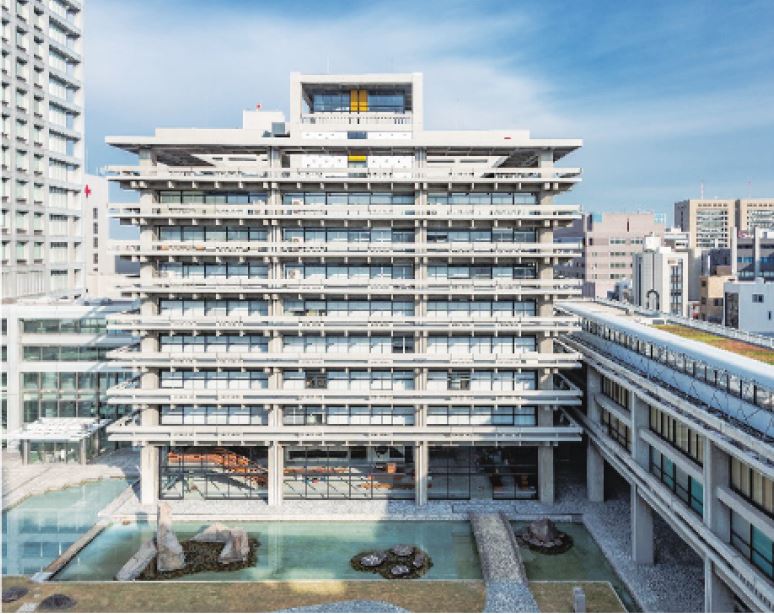
Keywords: Retrofit, Important cultural properties, RC Structure
This paper presents a retrofit project for the East Wing of the Kagawa Prefectural Government Building. Seismic diagnosis revealed a lack of seismic performance, but the building frame was determined to be capable of continued use. In order to maintain both the cultural value of the building and its function as a prefectural government building, the retrofit method was adopted under the foundation.
In order not to change the shape and appearance of the expansion joint between the high-rise and low-rise buildings, the two buildings were joined by a first-floor floor beam to form a single seismically isolated building.
The building has a direct foundation, but the supporting ground is not very strong, so temporary bearing piles were installed during excavation of the lower part of the foundation. To prevent the ground from collapsing during excavation, the excavation was reinforced by injecting a chemical liquid.
【Tokyo Station, retrofitted historical building】
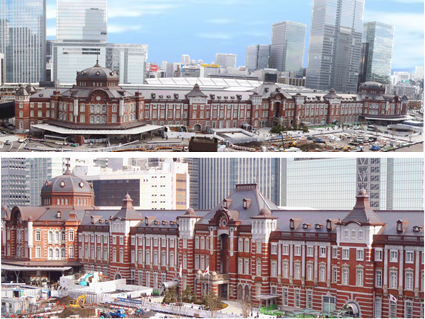
Keywords: Retrofit, Important cultural properties
This paper introduces the retrofit project of the Tokyo Station Marunouchi. A seismic isolation structure was adopted to restore the Tokyo Station, which has high historical value, to its original appearance while permanently utilizing it as an active building.
Since the horizontal clearance between the adjacent structures and the station building is small, the plan was to use oil dampers extensively to increase the damping force, thereby reducing the horizontal deformation during an earthquake to less than that of a typical seismic isolation structure.
The seismic isolation layer will be newly constructed between the existing steel-framed brick structure (the Important Cultural Property portion), which will be replaced with temporary bearing piles, and the first and second basement floors (the newly constructed portion), which was constructed using a reverse-driving method.
【Seismic Isolation Retrofit in Urban Area】
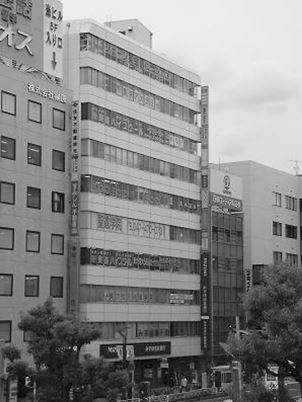
Keywords: Retrofit, Continuous use by tenants
This paper presents an example of a seismic retrofit for a building located in an urban area with a narrow distance between adjacent buildings. A new seismic isolation system was installed in the center of the third floor columns while the other floors remained in use by tenants.
In order to minimize the deformation of the seismic isolation layer, a seismic isolation construction method was adopted for the intermediate floor, in which a viscous damping device was actively placed in the "damping frame" (maximum damping force of 800 kN).
The following procedures (1) to (5) were used to isolate the columns. (1) Support jacks were installed between temporary jigs crimped on the top and bottom of the column. (2) Transfer the axial force of the column to the support jacks. (3) Cut the column. (4) Install laminated rubber and flat jacks. (5) Pressurize the flat jack to restore the axial force that had been transferred to the support jack.
【Tsutenkaku Tower (SI Retrofit)】
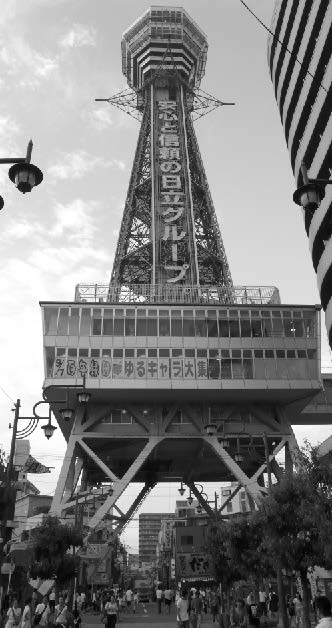
Keywords: Retrofit, Steel-framed tower
This paper presents a retrofit of Tsutenkaku tower, a 100-meter-high tower constructed in 1956. The seismic isolation structure was adopted because the retrofit work was to be done only at the base of the tower, which would not require any modification to the tower building, and because it would provide a sense of security to visitors during earthquakes. The seismic isolation layer was planned at the location where it would have the least intersection with visitor flow lines.
The "jack and lock damper" is installed which has not only functions as a normal oil damper during earthquakes, but also locks the damper during normal times to suppress deformation caused by strong winds.
The seismic isolation work was carried out by first completing the construction of the new frame for the seismic isolation structure while the existing frame remained in place, and then cutting the existing columns.
Technical Information
Recent trends of SI & VC buildings
JSSI accumulates these data for SI & VC buildings, with the cooperation of members.
These data were accumulated until the end of 2023.
Glossary of Seismic Isolation
The terminology for seismic isolation systems are as follows.
Differences in standards between countries
Comparison of Japanese and overseas design methods (including earthquake ground motion) regarding seismic isolation structures
In October 2022, "ISO 23618:2022 Bases for design of structures - General principles for seismically isolated structures" was published. Detailed design procedures of Japan (MLIT Notification No. 2009), China (GB/T 51408-2021), USA (ASCE 7-16) and Eurocode (EC8) are compared to propose a common design procedure for engineering practice.
Seismic isolation design codes are introduced first. Seismic load, analysis methods, major load combinations and device testing methods are compared. A 7-story RC building model is used to demonstrate the design procedures. Response results of response spectrum analysis method for equivalent linear system and response history analysis method are summarized at last.
